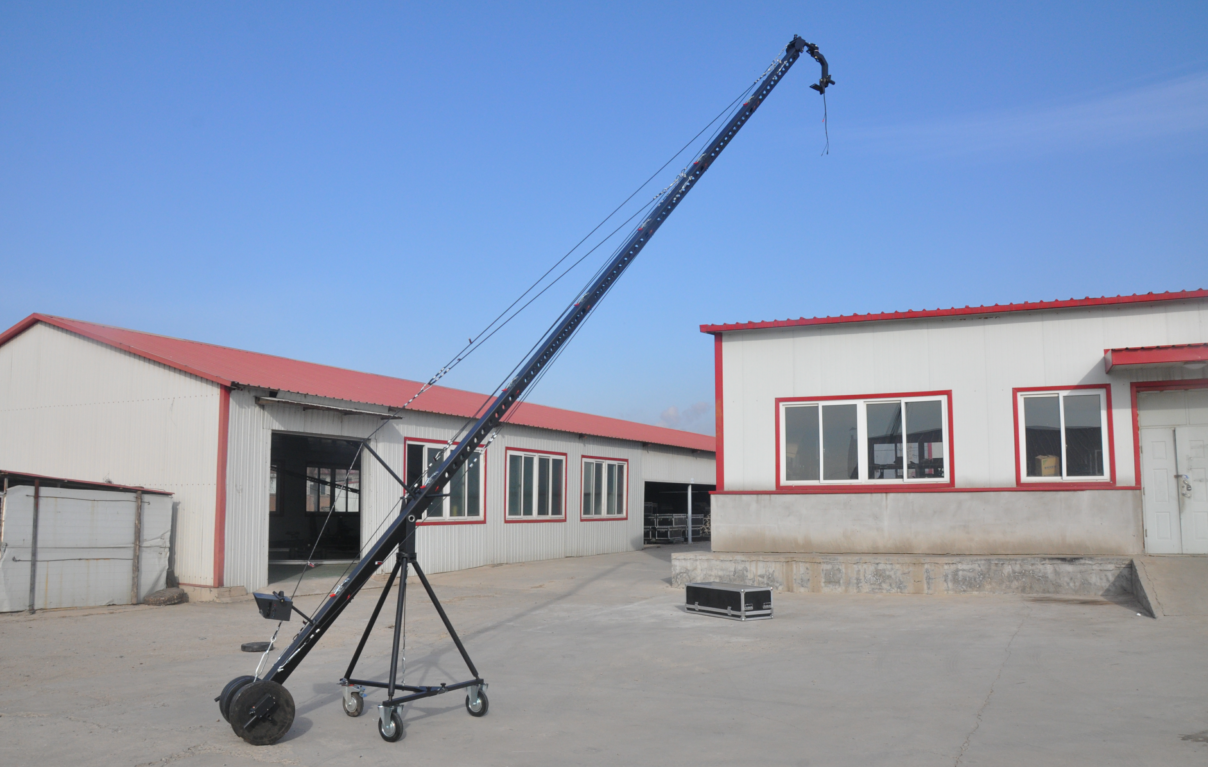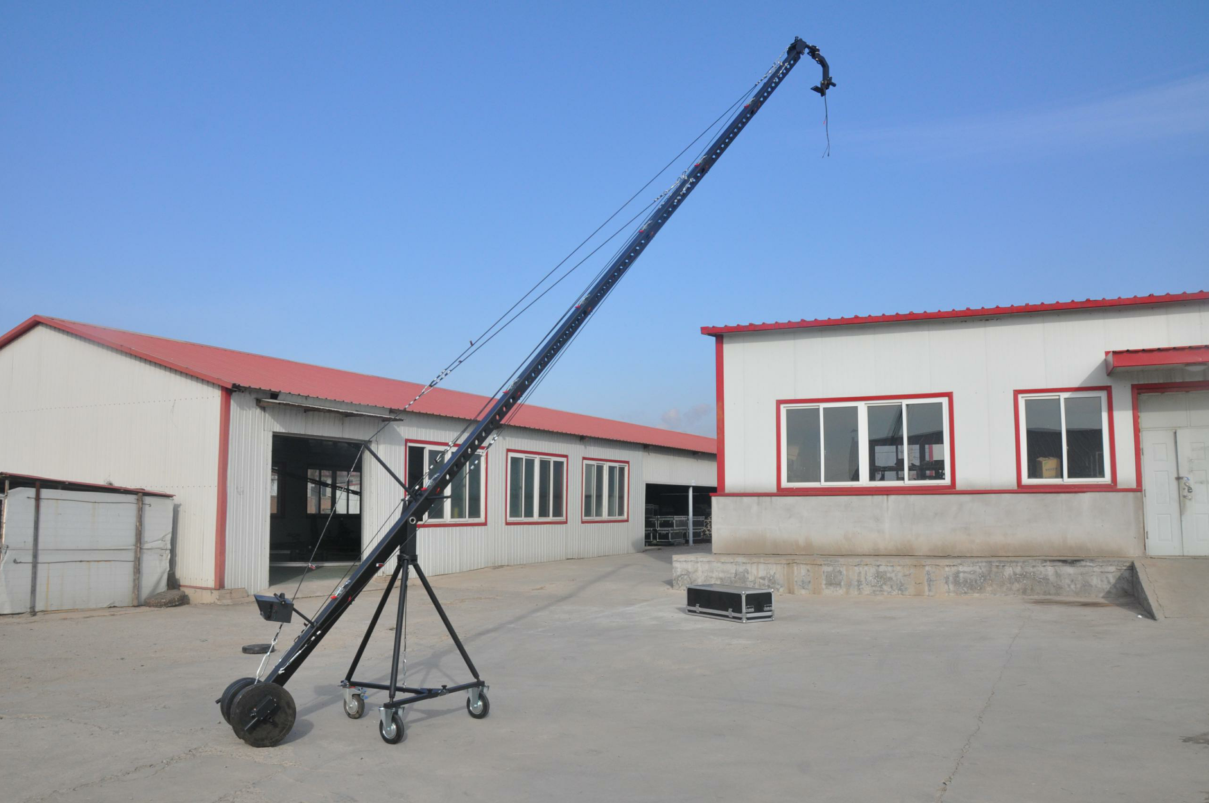Industry news
Home>News > Industry newsPrecautions for the operation and maintenance of the camera crane of the film and television
First, the camera crane
In the era of increasing DV technology, the camera crane technology has played an important role in variety, sports, conversation and other programs. And the rocker arm, as a special camera equipment, is widely used by TV stations and advertising companies. Especially in some large performances such as square performances, evening shows and other interactive programs. It greatly enriches the lens language of TV programs, increases the motion and diversity of the lens, adds momentum and depth of space to the lens, and makes the audience feel the feeling of the scene; and, because of the unique long arm advantage of the camera crane, it is often able to capture the lens that other cameras can't capture.

Swing up and down with left and right
In shooting work, shaking the lens is one of the most commonly used techniques. When the scene is too grand, if you can't shoot the whole picture with wide-angle lens, you should use the way of "panning".
Panoramic shot up and down and left and right panning, that is, the camera's position is unchanged, depending on the angle of the camera to shoot. The shooting method is often used in the following two situations: the first is when a big scene or a landscape is taken, this situation is often used at the beginning of the story piece that you have taken, like an opening, to introduce the location of the event and the position and environment of the leading character. The second situation is to track a moving target, such as an athlete in a high dive, something falling upstairs, or a running car.
(1) panning up and down
This shooting method can track the target moving up and down. In the event of an athlete's dive, the player stands at the height of the platform as the start, pushes the lens near, locks the target, and moves from the take-off to the water, and the lens moves along with the player's fall. This kind of scene is best to use close lens to shoot. If the mirror is suitable, just a few seconds, a single shot, visual impact is very strong. But shooting such a goal is difficult. The key is that the speed of the racket is not good enough to master and the mobile composition is difficult. Shooting must be repeated several times, unless you are "old bird", generally do not take too close to the lens to shoot.
Using the method of panning and panning is often used to show some scenes that are too high to be used in a complete picture, or to express the tall and majestic appearance of a certain scene. Tall buildings are the best targets to shoot up and down. Standing in front of a high building, first taking the base of the building with a flat method and moving the lens slowly up and down to the top of the high building ? a small set of lenses put the view of the whole building into sight, making the tall building spectacular.
Swing around
Using the lateral arc to move the camera, you can shoot a wide panorama or a moving target.
The method of panning is: first, the body faces the end of the shake, so that the camera is stable, toward the last point of the panning, then the body turns to the beginning of the shake and begins to shoot. The body rotates slowly and evenly to the ending direction until the whole panning process is completed.
When you are panning with a hand-held machine, your body usually does not need to rotate 90 degrees. If you exceed 90 degrees, you will feel uncomfortable. It will be harmful to the stability of the picture. The key to tracking the left and right moving targets with this panning method is to master the speed of the shake and keep it in sync with the moving speed of the target.
For example, we take a car from left to right. First we have to plan the route of the car and the start and end point of the panning; then take the camera body to the end point, turn the upper body against the clockwise and wait for the beginning of the target; once the target enters the picture, it begins to shoot, and turns the upper body at the right uniform speed as the car moves. The lens is always aligned with the moving vehicle until the end point is stopped, and there is no stopping in the middle. Attention should be paid to composition balance when panning. The walking space of the target is greater than its excess space. If you want to finish shooting, you can stop shaking the target and stop the camera for two or three seconds, so that the target will disappear slowly from the picture.
Shooting such a group of shots should be planned ahead of time, and there should be a preparatory process before shooting. In order to prepare the posture, wait for the target to appear, and can not wait for the target to get into the start point before grabbing the machine, so that haste pull the tie, there will be no good results. So it is necessary to make an advance amount.
The mirror should be smooth
When you are panning, you must smoothly move the camera lens. It is better to use three legs, which is conducive to capturing stable pictures. If a handset is used, the basic posture is to first stand on the feet by about 50 centimeters apart, the toes are a little out of the eight word type, and then shake the waist (attention is not the head, but not the knee). This can make the panoramic motion more stable.
No matter whether it is shot up or down, the action should be smooth and smooth, with smooth picture and no pause in the middle. Be careful not to move the lens too much, or to move the lens without any need. The starting point and terminal point of the shake must be properly grasped and the skills should be used in an appropriate way. To avoid shaking, like watering flowers. Don't just shake it back when you shake it up. You can only do a panoramic shooting around or around.

